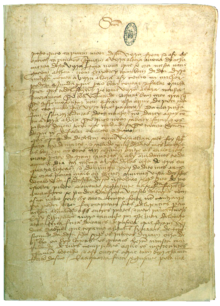- Carta de Pêro Vaz de Caminha
-
In his letter to Manuel I of Portugal, Pêro Vaz de Caminha gives what is considered by many today as being one of the most accurate accounts of what Brazil used to look like in 1500. "Arvoredo Tanto, e tamanho, e tão basto, e de tanta folhagem, que não se pode calcular", which roughly translates as "The vastness of the treeline and foliage is incalculable", is one of Pêro's most famous descriptions.
The admiral of the ship that sailed to Brazil sent Nicolau Coelho out to interact with the natives. The people they encountered when they arrived in Brazil were very primitive. They were dark brown in skin color and completely unclothed. Also, their languages did not relate, so they had to communicate through actions. They tried to give the natives things to eat such as bread, fish, cakes, honey and even wine. The natives took one taste of the things then spit them all out. They also tried to give them just water but the natives only swashed the water in their mouths, then spit it out. The one thing they did consent to was a cloak they could use to cover themselves while they slept
One of the admiral's objectives with the natives was to get them to accept Christianity. They set up a cross in the village of the natives and the explorers all went up, knelt in front of it and kissed it, to show the natives the importance of the symbol and their love of Christianity.
He describes on a diary form the first journey from Portugal to Brazil and their arrival in this country. This letter is considered the first document of the Brazilian history as much as its first literary text. The original of this 27-page document can be found in the Arquivo Nacional da Torre do Tombo, Lisbon.
External links
- (Portuguese) A Carta by Pêro Vaz de Caminha, the letter


This South American history-related article is a stub. You can help Wikipedia by expanding it.

